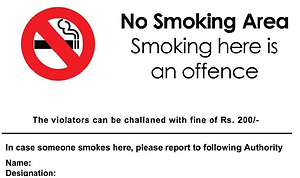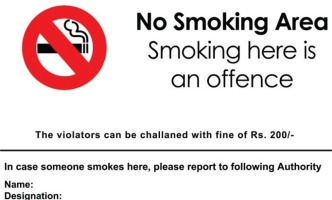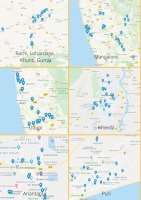INTRODUCTION
Tobacco use is a major risk factor for cancer and other non-communicable diseases and is the single largest cause of preventable deaths worldwide causing premature death in half of its users1,2. According to the Global Adult Tobacco Survey 2017, 28.6% of adults aged ≥15 years (approximately 266.8 million people) use some form of tobacco in India3.
There are various laws and legislations for tobacco control in India4. The Government of India enacted in 2004 its comprehensive tobacco control law the Cigarettes and other Tobacco Products Act 2003 (COTPA 2003) (prohibition of advertisement and regulation of trade and commerce, production, supply and distribution), to reduce tobacco use5. This Act includes: a) Section 4, prohibition of smoking in public places; b) Section 5, prohibition of advertisement of cigarettes and other tobacco products; c) Section 6, prohibition of sale of cigarettes or other tobacco products to anyone below the age of 18 years and in a particular area; and d) Section 7, prohibition on trade and commerce in production, supply, and distribution of cigarettes and other tobacco products6.
While promulgation of a law is usually a onetime process, its implementation is a continuous and more difficult process to enforce. According to the Global Youth Tobacco Survey (GYTS), 2009, 14.6% of students in India, aged 13–15 years, use tobacco7. Breslau et al.8 reported that persons who smoked their first cigarette at 14–16 years of age were 1.6 times more likely to become dependent than those who initiated smoking at an older age. Therefore, to achieve tobacco control amongst youth, it is essential that there should be strict enforcement of the COTPA Act in the vicinity of educational institutions. The Government of India released the ‘Guidelines for Tobacco-Free Schools/Educational Institutions’ in 2019 and ‘Step-by-Step Guidelines for implementation of Section 6b of the Act and Rules’ in 20179,10.
Since the premises of all educational institutions, by their nature, are public places, smoking inside the premises of an educational institution is a violation of Section 4 of the COTPA. For Section 6b, no tobacco products must be sold in an area within 100 yards (about 91 m) of the premises. The primary objective of this study was to determine any violation of COTPA Section 4 (prohibition of smoking in public places) around educational institutions and Section 6b (prohibition of sale of tobacco products near educational institutions). The secondary objective was to report the findings to the District Education Officer and Superintendent of Police in order to sensitize them on the need for better enforcement of COTPA laws related to educational institutions.
METHODS
Between November and December 2019, a crosssectional, observational study was conducted in 307 schools and colleges selected across 12 districts in 5 states (Jharkhand, Karnataka, Andhra Pradesh, Uttar Pradesh, Odisha) in India. The educational institutions were selected using random sampling. The schools were anonymized. Schools within a 10 km radius from the center of the city were selected. The data were collected by the tobacco control coordinators of the Tata Trusts Cancer Care Programme. The outcome measures were rates of violation of Sections 4 and 6b of COPTA:
Display of ‘No Smoking Area – Smoking here is An Offence’ signage in the entrance(s) of educational institutions, as per Section 4 of COTPA. Such signage must be of 90 × 60 cm dimensions. A typical signage is shown in Figure 1.
Shops selling tobacco products within a radius of 100 yards of the educational institutions, as per Section 6b of COTPA.
To measure the violation of Section 6b, the data collectors measured a radial distance of approximately 120 yards from the educational institution’s entrances/exits, wherever possible, using Google Maps, and checked if there were any shops selling tobacco products within this radius. The observations were recorded photographically. The geographical locations of the educational institutions are shown in Figures 2 and 3.
A descriptive analysis was performed to report the data. No personnel of the educational institutions or any authority outside the institutions were interviewed or informed about the survey.
RESULTS
Out of 307 schools observed, on average 85% of the schools violated Section 4 – no signage displaying ‘No Smoking Area – Smoking here is An Offence’, and on average 69% violated Section 6b – shops selling tobacco products within a radius of 100 yards of schools (Table 1).
Violation of Section 4 of COTPA
It was observed (Figure 4) that in Anantapur and Chittoor districts of Andhra Pradesh, 100% of the educational institutions violated Section 4. In Prayagraj district of Uttar Pradesh an average of 96%, in Khordha, Cuttack and Puri districts of Odisha an average of 91%, in Gumla, Khunti, Lohardaga and Ranchi districts of Jharkhand an average of 90% and in Dakshina Kanada and Udupi districts of Karnataka an average of 44% educational institutions violated Section 4.
Violation of Section 6b of COTPA
In Anantapur and Chittoor districts of Andhra Pradesh, an average of 80%, in Prayagraj district of Uttar Pradesh an average of 96%, in Khordha, Cuttack and Puri districts of Odisha an average of 90%, in Gumla, Khunti, Lohardaga and Ranchi districts of Jharkhand an average of 74% and in Dakshina Kanada and Udupi districts of Karnataka an average of 4% educational institutions (Figure 5) violated Section 6b.
DISCUSSION
The COTPA was poorly enforced in the 307 schools and colleges selected across 12 districts in 5 states in India. Even in those educational institutions where the signage boards were displayed, many were in poor condition. While on average 44% of the educational institutions observed in Karnataka violated Section 4 of COTPA, violations of Section 4 were observed in more than 90% of the observed educational institutions in Andhra Pradesh, Uttar Pradesh, Jharkhand, and Odisha. Since the study was conducted as part of a strategy to sensitize higher officers on COTPA law, a modest sample size was required and, hence, a defined area within the city was chosen.
The observed educational institutions in Dakshina Kanada and Udupi districts of Karnataka reported on average 4% violations, whereas all the other districts reported more than 74% violations of Section 6b of COTPA. A similar study conducted in Bangalore city among 200 educational institutions and public places showed 67% violated Section 4 and 47% violated Section 6b11. A study conducted by Hriday Organisation in Delhi and Tamil Nadu also reported similar results. Overall, 89% of the public places did not display the ‘No Smoking Area – Smoking here is An Offence’ signage at any entrance12.
Students, teachers, law enforcers and the community must be made aware of the COTPA laws, and efforts must be made to ensure its compliance. There are several persons authorized to enforce Sections 4 and 6b of COPTA9. It is also the role of the person in-charge of affairs at the educational institution to ensure compliance10.
The police officials and school/college management are best positioned to ensure strict compliance of COTPA. While Section 4 can be enforced by the active participation of the school authorities, enforcement of Section 6b by the school authorities would require the help of police officers, as it requires dealing with shopkeepers selling tobacco products. Training of education and police officials on COTPA laws for educational institutions must be conducted at the district and block level with the help of the District Tobacco Control Cell. Violations of sale of tobacco products around educational institutions must be reported to the nearest police station or the National Quitline (1800-11-2356)9.
The objective of these guidelines was to provide fresh momentum to the implementation of tobacco control initiatives among adolescents and young adults. This will play a pivotal role in ensuring COTPA implementation in educational institutions, which will stimulate positive changes in and around them, potentially leading to higher quit rates and lesser rates of initiation of tobacco use among the students9. It is also important to sensitize the District Education Officer and Block Education Officers on these guidelines, which will help in better monitoring. This study helps to understand the level of implementation of COTPA Sections 4 and 6b across five states in India. The findings of the study were shared with the respective State and District Education Officers and Superintendent of Police of the respective districts, which led to a series of trainings of the police officials and blockeducation officers. The trainings for police were conducted at district level and at the police stations. Simultaneously, in order to improve compliance, the Superintendent of Police incorporated the status of implementation of COTPA as part of district monthly crime review meetings. This strategy should prove to be effective in motivating action on COTPA among the primary enforcement agencies and regularize reporting of violations of the Act.
Limitations
This study had limitations. The challenges in the implementation of COTPA may be better understood by interviewing school authorities and police officers. The study focused on only two sections of the COTPA law (Sections 4 and 6b). Section 5 – prohibiting direct and indirect advertisements of tobacco products, and Section 7 – mandatory pictorial warnings, could have given a more comprehensive analysis of tobacco control law implementation across different regions in India.
CONCLUSIONS
This cross-sectional study showed that COTPA 2003 (Sections 4 and 6b) is poorly implemented in many states in India. A coordinated effort from all stakeholders, especially from the police, educational institutions, and the community, is required to improve this situation. There is a need for creating greater public awareness about the harmful effects of tobacco so that there is more voluntary compliance with the regulations. Complying to the guidelines on Tobacco-Free Educational Institutions can provide a holistic approach to tobacco control and improve the implementation of COTPA in and around educational institutions. The results of this study will help in advocating for better implementation of the tobacco laws and guidelines in the respective states involved in this study and in the country overall.







